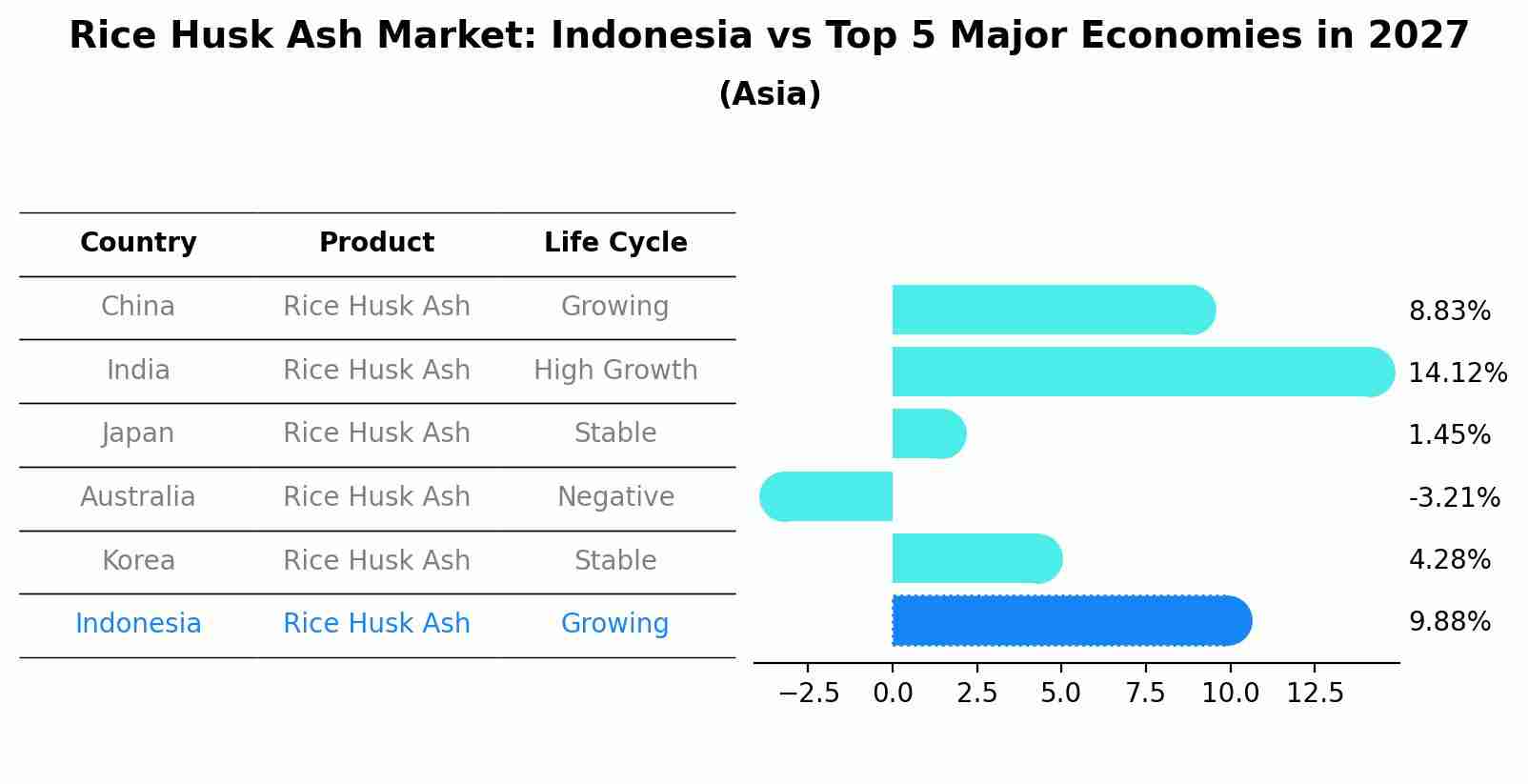Indonesia Rice Husk Ash Market | Size, Trends, Growth, Analysis, Forecast, COVID-19 IMPACT, Industry, Revenue, Share, Value & Companies
| Product Code: ETC178727 | Publication Date: Jul 2023 | Updated Date: Apr 2025 | Product Type: Market Research Report | |
| Publisher: 6Wresearch | No. of Pages: 70 | No. of Figures: 35 | No. of Tables: 5 | |
Indonesia Rice Husk Ash Market Size Growth Rate
The Indonesia Rice Husk Ash Market is likely to experience consistent growth rate gains over the period 2025 to 2029. From 8.43% in 2025, the growth rate steadily ascends to 11.83% in 2029.

Rice Husk Ash Market: Indonesia vs Top 5 Major Economies in 2027 (Asia)
The Rice Husk Ash market in Indonesia is projected to grow at a growing growth rate of 9.88% by 2027, highlighting the country's increasing focus on advanced technologies within the Asia region, where China holds the dominant position, followed closely by India, Japan, Australia and South Korea, shaping overall regional demand.

Indonesia Rice Husk Ash MarketSynopsis
Rice husk ash is a by-product of rice milling and is used as an additive in cement, concrete, ceramics, and other industries. It also has the potential to be used as pozzolanic material for construction purposes. In Indonesia, rice husk ash has been widely used in brick production since 2000 due to its ability to reduce energy consumption during firing compared with clay bricks.
Market Trends
Recent trends in the Indonesia rice husk ash market include increasing demand from various industrial sectors such as paper manufacturing, paints & coatings and cosmetics & personal care products. Increasing demand from these industries coupled with advancements in technology have improved the quality of rice husk ash produced which has resulted in increased utilization of this product across different applications. Additionally, high environmental consciousness among consumers has further contributed towards rising usage of this natural resource derived fuel for industrial processes thereby driving growth opportunities for producers operating within this industry space.
Market Drivers
The main drivers contributing towards sustained growth within the Indonesia market are fueled largely by robust infrastructure development activities along with increasing investments into residential developments across the country which have together spurred up demand for higher grade building materials including those that use additives like Rice Husk Ash (RHA). Other key factors driving market dynamics here include government support initiatives targeted at promoting green building practices alongside burgeoning mining activities both responsible for boosting overall RHA consumption over time period under review. Furthermore booming e-commerce channels that offer easy access and purchase options are also adding significantly to rapid expansion witnessed here on back of heightened consumer awareness surrounding benefits associated with using eco-friendly alternatives like RHA when it comes to construction related operations and processes.
COVID-19 Impact on the Market
The main drivers contributing towards sustained growth within the Indonesia market are fueled largely by robust infrastructure development activities along with increasing investments into residential developments across the country which have together spurred up demand for higher grade building materials including those that use additives like Rice Husk Ash (RHA). Other key factors driving market dynamics here include government support initiatives targeted at promoting green building practices alongside burgeoning mining activities both responsible for boosting overall RHA consumption over time period under review. Furthermore booming e-commerce channels that offer easy access and purchase options are also adding significantly to rapid expansion witnessed here on back of heightened consumer awareness surrounding benefits associated with using eco-friendly alternatives like RHA when it comes to construction related operations and processes.
Challenges of the Market
The main drivers contributing towards sustained growth within the Indonesia market are fueled largely by robust infrastructure development activities along with increasing investments into residential developments across the country which have together spurred up demand for higher grade building materials including those that use additives like Rice Husk Ash (RHA). Other key factors driving market dynamics here include government support initiatives targeted at promoting green building practices alongside burgeoning mining activities both responsible for boosting overall RHA consumption over time period under review. Furthermore booming e-commerce channels that offer easy access and purchase options are also adding significantly to rapid expansion witnessed here on back of heightened consumer awareness surrounding benefits associated with using eco-friendly alternatives like RHA when it comes to construction related operations and processes.
Industry Key Players
Some key players operating within the Indonesia rice husk ash market include PT Panarub Industry (PT PIP), PT Sumber Marihuana Indah (SMI) and PT Jati Mas Abadi (JMA). These firms dominate much of the production landscape with their vertically integrated business models covering everything from sourcing raw materials right through to distribution channels across various end user markets including cement plants, power generation facilities etc.. Furthermore they also benefit from having extensive experience in providing customised solutions tailored specifically towards customers? individual requirements thus helping them gain competitive advantage over other competitors operating within same space.
Key Highlights of the Report:
- Indonesia Rice Husk Ash Market Outlook
- Market Size of Indonesia Rice Husk Ash Market, 2023
- Forecast of Indonesia Rice Husk Ash Market, 2030
- Historical Data and Forecast of Indonesia Rice Husk Ash Revenues & Volume for the Period 2020-2030
- Indonesia Rice Husk Ash Market Trend Evolution
- Indonesia Rice Husk Ash Market Drivers and Challenges
- Indonesia Rice Husk Ash Price Trends
- Indonesia Rice Husk Ash Porter's Five Forces
- Indonesia Rice Husk Ash Industry Life Cycle
- Historical Data and Forecast of Indonesia Rice Husk Ash Market Revenues & Volume By Silica Content for the Period 2020-2030
- Historical Data and Forecast of Indonesia Rice Husk Ash Market Revenues & Volume By 80-84% for the Period 2020-2030
- Historical Data and Forecast of Indonesia Rice Husk Ash Market Revenues & Volume By 85-89% for the Period 2020-2030
- Historical Data and Forecast of Indonesia Rice Husk Ash Market Revenues & Volume By 90-94% for the Period 2020-2030
- Historical Data and Forecast of Indonesia Rice Husk Ash Market Revenues & Volume By Greater Than 95% for the Period 2020-2030
- Historical Data and Forecast of Indonesia Rice Husk Ash Market Revenues & Volume By Silica Extraction Process for the Period 2020-2030
- Historical Data and Forecast of Indonesia Rice Husk Ash Market Revenues & Volume By Alkaline Extraction for the Period 2020-2030
- Historical Data and Forecast of Indonesia Rice Husk Ash Market Revenues & Volume By Precipitated Silica Extraction for the Period 2020-2030
- Historical Data and Forecast of Indonesia Rice Husk Ash Market Revenues & Volume By Mesoporous Silica Extraction for the Period 2020-2030
- Historical Data and Forecast of Indonesia Rice Husk Ash Market Revenues & Volume By Sol-Gel Method for the Period 2020-2030
- Historical Data and Forecast of Indonesia Rice Husk Ash Market Revenues & Volume By Application for the Period 2020-2030
- Historical Data and Forecast of Indonesia Rice Husk Ash Market Revenues & Volume By Building and Construction for the Period 2020-2030
- Historical Data and Forecast of Indonesia Rice Husk Ash Market Revenues & Volume By Steel Industry for the Period 2020-2030
- Historical Data and Forecast of Indonesia Rice Husk Ash Market Revenues & Volume By Ceramics and Refractory for the Period 2020-2030
- Historical Data and Forecast of Indonesia Rice Husk Ash Market Revenues & Volume By Rubber for the Period 2020-2030
- Historical Data and Forecast of Indonesia Rice Husk Ash Market Revenues & Volume By Others for the Period 2020-2030
- Indonesia Rice Husk Ash Import Export Trade Statistics
- Market Opportunity Assessment By Silica Content
- Market Opportunity Assessment By Silica Extraction Process
- Market Opportunity Assessment By Application
- Indonesia Rice Husk Ash Top Companies Market Share
- Indonesia Rice Husk Ash Competitive Benchmarking By Technical and Operational Parameters
- Indonesia Rice Husk Ash Company Profiles
- Indonesia Rice Husk Ash Key Strategic Recommendations
Frequently Asked Questions About the Market Study (FAQs):
1 Executive Summary |
2 Introduction |
2.1 Key Highlights of the Report |
2.2 Report Description |
2.3 Market Scope & Segmentation |
2.4 Research Methodology |
2.5 Assumptions |
3 Indonesia Rice Husk Ash Market Overview |
3.1 Indonesia Country Macro Economic Indicators |
3.2 Indonesia Rice Husk Ash Market Revenues & Volume, 2020 & 2030F |
3.3 Indonesia Rice Husk Ash Market - Industry Life Cycle |
3.4 Indonesia Rice Husk Ash Market - Porter's Five Forces |
3.5 Indonesia Rice Husk Ash Market Revenues & Volume Share, By Silica Content, 2020 & 2030F |
3.6 Indonesia Rice Husk Ash Market Revenues & Volume Share, By Silica Extraction Process, 2020 & 2030F |
3.7 Indonesia Rice Husk Ash Market Revenues & Volume Share, By Application, 2020 & 2030F |
4 Indonesia Rice Husk Ash Market Dynamics |
4.1 Impact Analysis |
4.2 Market Drivers |
4.3 Market Restraints |
5 Indonesia Rice Husk Ash Market Trends |
6 Indonesia Rice Husk Ash Market, By Types |
6.1 Indonesia Rice Husk Ash Market, By Silica Content |
6.1.1 Overview and Analysis |
6.1.2 Indonesia Rice Husk Ash Market Revenues & Volume, By Silica Content, 2020-2030F |
6.1.3 Indonesia Rice Husk Ash Market Revenues & Volume, By 80-84%, 2020-2030F |
6.1.4 Indonesia Rice Husk Ash Market Revenues & Volume, By 85-89%, 2020-2030F |
6.1.5 Indonesia Rice Husk Ash Market Revenues & Volume, By 90-94%, 2020-2030F |
6.1.6 Indonesia Rice Husk Ash Market Revenues & Volume, By Greater Than 95%, 2020-2030F |
6.2 Indonesia Rice Husk Ash Market, By Silica Extraction Process |
6.2.1 Overview and Analysis |
6.2.2 Indonesia Rice Husk Ash Market Revenues & Volume, By Alkaline Extraction, 2020-2030F |
6.2.3 Indonesia Rice Husk Ash Market Revenues & Volume, By Precipitated Silica Extraction, 2020-2030F |
6.2.4 Indonesia Rice Husk Ash Market Revenues & Volume, By Mesoporous Silica Extraction, 2020-2030F |
6.2.5 Indonesia Rice Husk Ash Market Revenues & Volume, By Sol-Gel Method, 2020-2030F |
6.3 Indonesia Rice Husk Ash Market, By Application |
6.3.1 Overview and Analysis |
6.3.2 Indonesia Rice Husk Ash Market Revenues & Volume, By Building and Construction, 2020-2030F |
6.3.3 Indonesia Rice Husk Ash Market Revenues & Volume, By Steel Industry, 2020-2030F |
6.3.4 Indonesia Rice Husk Ash Market Revenues & Volume, By Ceramics and Refractory, 2020-2030F |
6.3.5 Indonesia Rice Husk Ash Market Revenues & Volume, By Rubber, 2020-2030F |
6.3.6 Indonesia Rice Husk Ash Market Revenues & Volume, By Others, 2020-2030F |
7 Indonesia Rice Husk Ash Market Import-Export Trade Statistics |
7.1 Indonesia Rice Husk Ash Market Export to Major Countries |
7.2 Indonesia Rice Husk Ash Market Imports from Major Countries |
8 Indonesia Rice Husk Ash Market Key Performance Indicators |
9 Indonesia Rice Husk Ash Market - Opportunity Assessment |
9.1 Indonesia Rice Husk Ash Market Opportunity Assessment, By Silica Content, 2020 & 2030F |
9.2 Indonesia Rice Husk Ash Market Opportunity Assessment, By Silica Extraction Process, 2020 & 2030F |
9.3 Indonesia Rice Husk Ash Market Opportunity Assessment, By Application, 2020 & 2030F |
10 Indonesia Rice Husk Ash Market - Competitive Landscape |
10.1 Indonesia Rice Husk Ash Market Revenue Share, By Companies, 2023 |
10.2 Indonesia Rice Husk Ash Market Competitive Benchmarking, By Operating and Technical Parameters |
11 Company Profiles |
12 Recommendations |
13 Disclaimer |
- Single User License$ 1,995
- Department License$ 2,400
- Site License$ 3,120
- Global License$ 3,795
Search
Related Reports
- Portugal Electronic Document Management Market (2025-2031) | Strategy, Consumer Insights, Analysis, Investment Trends, Opportunities, Growth, Size, Share, Industry, Revenue, Segments, Value, Segmentation, Supply, Forecast, Restraints, Outlook, Competition, Drivers, Trends, Demand, Pricing Analysis, Competitive, Strategic Insights, Companies, Challenges
- France Electronic Document Management Market (2025-2031) | Strategy, Consumer Insights, Analysis, Investment Trends, Opportunities, Growth, Size, Share, Industry, Revenue, Segments, Value, Segmentation, Supply, Forecast, Restraints, Outlook, Competition, Drivers, Trends, Demand, Pricing Analysis, Competitive, Strategic Insights, Companies, Challenges
- Portugal Occupational Health & Safety Services Market (2025-2031) | Strategy, Consumer Insights, Analysis, Investment Trends, Opportunities, Growth, Size, Share, Industry, Revenue, Segments, Value, Segmentation, Supply, Forecast, Restraints, Outlook, Competition, Drivers, Trends, Demand, Pricing Analysis, Competitive, Strategic Insights, Companies, Challenges
- Netherlands Occupational Health and Safety Services Market (2025-2031) | Strategy, Consumer Insights, Analysis, Investment Trends, Opportunities, Growth, Size, Share, Industry, Revenue, Segments, Value, Segmentation, Supply, Forecast, Restraints, Outlook, Competition, Drivers, Trends, Demand, Pricing Analysis, Competitive, Strategic Insights, Companies, Challenges
- Belgium and Luxembourg Facility Management Market (2025-2031) | Strategy, Consumer Insights, Analysis, Investment Trends, Opportunities, Growth, Size, Share, Industry, Revenue, Segments, Value, Segmentation, Supply, Forecast, Restraints, Outlook, Competition, Drivers, Trends, Demand, Pricing Analysis, Competitive, Strategic Insights, Companies, Challenges
- Russia Women Intimate Apparel Market (2025-2031) | Strategy, Consumer Insights, Analysis, Investment Trends, Opportunities, Growth, Size, Share, Industry, Revenue, Segments, Value, Segmentation, Supply, Forecast, Restraints, Outlook, Competition, Drivers, Trends, Demand, Pricing Analysis, Competitive, Strategic Insights, Companies, Challenges
- Africa Chocolate Market (2025-2031) | Size, Share, Trends, Growth, Revenue, Analysis, Forecast, industry & Outlook
- Global Hydroxychloroquine And Chloroquine Market (2025-2031) | Industry, Trends, Size, Outlook, Growth, Value, Companies, Revenue, Analysis, Share, Forecast
- Saudi Arabia Plant Maintenance Market (2025-2031) | Industry, Size, Growth, Revenue, Value, Companies, Forecast, Analysis, Share & Trends
- Taiwan Electric Truck Market (2025-2031) | Outlook, Industry, Revenue, Size, Forecast, Growth, Analysis, Share, Companies, Value & Trends
Industry Events and Analyst Meet
Our Clients
Whitepaper
- Middle East & Africa Commercial Security Market Click here to view more.
- Middle East & Africa Fire Safety Systems & Equipment Market Click here to view more.
- GCC Drone Market Click here to view more.
- Middle East Lighting Fixture Market Click here to view more.
- GCC Physical & Perimeter Security Market Click here to view more.
6WResearch In News
- Doha a strategic location for EV manufacturing hub: IPA Qatar
- Demand for luxury TVs surging in the GCC, says Samsung
- Empowering Growth: The Thriving Journey of Bangladesh’s Cable Industry
- Demand for luxury TVs surging in the GCC, says Samsung
- Video call with a traditional healer? Once unthinkable, it’s now common in South Africa
- Intelligent Buildings To Smooth GCC’s Path To Net Zero













